Taking the temperature of hate
Associations and foundations that work on the ground with groups that suffer hate crimes and hate speech function as thermometers: they are able to identify growing trends, act as early warning devices, raise their voice against potentially dangerous discourse and, above all, provide detailed information on the individual acts in their reports. This last point is important: detailed case studies provide information that goes unnoticed in wider-ranging statistics.
However, only a few organisations are recognised by the OSCE, so there is a whole world of associations able to provide data that are difficult to monitor to run a comprehensive survey. For this reason, we are presenting infographics of the unofficial data from the organisations under the OSCE umbrella, although other data are specified in each country.
This part of the report includes a register of almost 6,000 acts of hate reported by 141 organisations, associations and media from all six countries. The events took place between 1 January 2015 and 30 June 2020. Excepting data for 2015, all the records include an individual description of the incitement, allowing us to widen the study variable range in comparison with official statistics.
Detailed analysis of the data helps us differentiate between low-intensity and high-intensity hate. The former refers to manifestations of hatred without a direct impact on individuals; rather, they tend to be attacks on property. High-intensity hate is related to the severity of personal attacks on the victims of hate.
These new variables include an important aspect based on individual case analysis: the number of victims. An effort has also been made to reflect the complexity of the situation, determining what we call “linked up motives”. In the light of the data, these occur when hate starts and can lead to violence plus a motive or prejudice.
In the last section of this analysis, we include a selection of particularly significant cases in each of the study countries, which we believe condense or symbolise a type of spirit of hate.
The report includes a record of almost 6,000 acts of hate reported by 141 organisations, associations and media in all six countries. The acts took place between 1 January 2015 and 30 June 2020
2019, the year confirming the rise of hate
In 2019, civil society organisations recorded a 21% increase in acts of hate in the analysis countries. According to this gauging, acts of hate have risen most in Spain and Poland since 2019. In Spain, as we will analyse later, the rise would be characterised by acts related to political intolerance, which is now systematically recorded. In Poland, the figures have doubled on the previous year and, as we shall also see later, the increase concentrates on acts motivated by racism, xenophobia and homophobia. The data for Hungary show deficiencies that hamper collection of statistics, due to the lack of organisations that document hate acts systematically.
The case of France is striking, particularly if we focus on the most recent figures: just in the first half of 2020, the organisations recorded more acts of hate than in the whole of 2019, indicating a clear uptick. In contrast, Germany shows a clear downward trend in the number of acts of hate recorded by OSCE-recognised organisations.
The data for 2020, a year marked by the Covid-19 pandemic, confirm the rising trend, although they are incomplete for two basic reasons: 1) our study only covers the first six months of the year, and 2) some organisations only publish their complete data at the end of the year in question. It has not been a year of full freedom of movement, which affected the study.

The pandemic has slowed down the activity of many Human Rights Observatories and data collection has been distorted by the health situation. The crimes are still committed, but they are not sufficiently recorded or reported.
Figure 18: Total hate crime over time, 2015-June 2020
*Data for the first 6 months of 2020
Table 10: Yearly evolution of hate crimes by country, 2015-june 2020
Severe data defecit concerning hate crimes in Polond and Hungary due to lack of follow-up and observatories
| PAÍS | Total | Total (%) | 2015 | 2016 | 2017 | 2018 | 2019 | 2020 |
|---|---|---|---|---|---|---|---|---|
| Germany | 994 | 16,59% | 379 | 180 | 164 | 210 | 42 | 19 |
| Spain | 1.362 | 22,74% | 85 | 83 | 317 | 331 | 517 | 29 |
| France | 1.627 | 27,16% | 742 | 269 | 178 | 221 | 105 | 112 |
| Hungary* | 137 | 2,29% | 42 | 15 | 30 | 25 | 24 | 1 |
| Italy | 1.102 | 18,40% | 164 | 101 | 154 | 290 | 292 | 101 |
| Poland* | 768 | 12,82% | 96 | 93 | 135 | 106 | 293 | 45 |
| TOTAL | 5.990 | - | 1.508 25,18% | 741 12,37% | 978 16,33% | 1.183 19,75% | 1.273 21,25% | 307 5,13% |
From 2015 to mid-2020, civil society organisations recorded 4,088 victims of acts of hate in the six countries analysed. France has the highest number of victims recorded in terms of accumulated data with 1.337 (32.71% of the total); this figure that can be explained by good data compilation, but also by the high number of mortal victims and people injured in various hate-motivated terrorist attacks that have affected the country. Italy lies second in terms of the number of victims, with 948 (23.19% of the total) and it also heads this statistic in the last three years analysed (2018, 2019 and 2020). Spain is in third place with 859 victims.
Of these 4,088 victims, 1,362 were victims of terrorist attacks, included in this report as they are considered the ultimate and most extreme expression of hate. Nevertheless, if we leave aside terrorist attacks, 87 deaths from hate crimes can be identified, thanks to verification of data from various sources in this study. Spain reports 32 victims identified by civil society observatories and the Press, followed by Italy, where there is a higher number (23) due to racism, xenophobia and homophobia.
Civil society organisations have recorded 4,088 victims of acts of hate in all six counetries
Table 11: Total number of victims recorded by Civil Society, 2015-june 2020
* Severe deficit of hate crime data in Poland and Hungary due to lack of monitoring and observatories
| PAÍS | Total | Total (%) | 2015 | 2016 | 2017 | 2018 | 2019 | 2020 |
|---|---|---|---|---|---|---|---|---|
| Germany | 547 | 13,38% | 88 | 211 | 82 | 117 | 30 | 19 |
| Spain | 859 | 21,01% | 6 | 31 | 392 | 176 | 213 | 41 |
| France | 1.337 | 32,71% | 523 | 636 | 42 | 84 | 27 | 25 |
| Hungary* | 57 | 1,39% | 20 | 2 | 12 | 17 | 4 | 2 |
| Italy | 948 | 23,19% | 5 | 45 | 120 | 354 | 354 | 70 |
| Poland* | 340 | 8,32% | 1 | 60 | 82 | 74 | 101 | 22 |
| TOTAL | 4.088 | - | 634 15,73% | 985 24,09% | 730 17,86% | 822 20,11% | 729 17,83% | 179 4,38% |
Figure 19: Total hate crime over time, 2015-June 2020
- Percentages (%)
Figure 20: Map of Europe total number and percentage of hate crimes by country
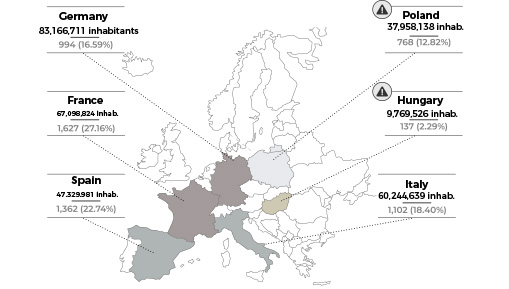
Table 12: Total number of incidents by country and motivation, recorded by Civil Society
| Total | Total (%) | Germany | Spain | France | Hungary | Italy | Poland | |
|---|---|---|---|---|---|---|---|---|
| Anti-Christianism and other religions | 1.428 | 23,84% | 172 | 199 | 767 | 3 | 127 | 199 |
| Anti-Semitism | 1.107 | 18,48% | 291 | 30 | 500 | 81 | 112 | 93 |
| Racism and xenophobia | 1.042 | 17,40% | 60 | 62 | 60 | 35 | 609 | 216 |
| Crimes against sexual orientationl | 914 | 15,26% | 291 | 303 | 48 | 7 | 86 | 179 |
| Islamophobia | 576 | 9,62% | 163 | 114 | 221 | 3 | 34 | 41 |
| Political intolerance | 524 | 8,75% | 12 | 464 | 17 | 1 | 1 | 29 |
| Victims of terrorism | 110 | 1,84% | 0 | 109 | 0 | 0 | 0 | 1 |
| Anti-Gypsyism | 78 | 1,30% | 0 | 0 | 2 | 7 | 54 | 15 |
| Attacks against the rule of law | 71 | 1,18% | 0 | 70 | 0 | 0 | 0 | 1 |
| Covid-19 discrimination | 70 | 1,17% | 5 | 6 | 12 | 0 | 22 | 25 |
| Persons with disabilities | 49 | 0,82% | 0 | 1 | 0 | 0 | 44 | 4 |
| Holocaust victims | 17 | 0,28% | 0 | 0 | 0 | 0 | 13 | 4 |
| Aporophobia | 4 | 0,07% | 0 | 4 | 0 | 0 | 0 | 0 |
| TOTAL | 5.990 | -- | 994 | 1.362 | 1.627 | 137 | 1.102 | 768 |
Hate against Christian symbols is the main expression of low-intensity hate in the analysis countries: at least 1,366 acts, representing 23% of the cases recorded. A large majority (1,253) are attacks on property, mostly against places of worship and cemeteries. The country with by far the highest number of this type of acts is France, where more than half of the cases are recorded. As for attacks on individuals, there are 117, of which 11 caused the victim’s death.
The second most considerable motive is anti-Semitism, which has led to at least 1,107 acts of hatred, 18% of the total. In this case, as in attacks against Christian symbols, most are on property, with a total of 718. However, a wider variety of places were attacked than acts against Christian symbols: as well as places of worship and cemeteries, attacks on memorials to victims of the Holocaust and graffiti in public places are also common. Once again, France is the country with the highest number of recorded acts (500), followed by Germany, which also presents a high figure: 291.
If we add up the figures, religious intolerance towards Christianity, Judaism, Islam and other
religions represents more than half of the total cases recorded: 52%
Case studies
![]() Source: Observatory of Intolerance and Discrimination against Christians
Source: Observatory of Intolerance and Discrimination against Christians
ARSON IN THE CHURCH OF SAINT SULPICE IN PARIS. . On Sunday 17 March, the church of Saint-Sulpice in Paris had to be evacuated after a major fire affected the large door of the transept and the upper stained glass window, which were seriously damaged. The authorities confirmed that it was a case of arson.
Comparing figures from civil society with official data, we see that the three most common catalysts of hate are repeated, although to a different extent. In the official data, racism, xenophobia and factors related to religious hate are the main reasons behind hate crimes, followed by anti-Semitism and attacks on Christian symbols.
Data analysis shows that motives behind hate might be under-represented for many reasons, due to few organisations monitoring data or the lack of detailed, individualised records of acts of hate, which make up the methodology used for this report. Motives that are surely under-represented would include hate against persons with disabilities or Romanies.
The most serious cases occur when various vectors of hate come together. This is the case of racism on top of other motives, making these individuals particularly vulnerable, e.g. transexuals and/or poor people.
Poverty can lead to greater vulnerability, as potential attackers forget any social inhibitions they may have and attack poor people.
An analysis of the data shows that motives behind hate might be under-represented for many reasons, due to few organisations monitoring data or the lack of detailed and individualised records
Revictimization (or double victimisation) occurs when the victim of a serious crime is subsequently subjected to poor institutional support, social isolation, the high media profile of the murderers, a sensation of impunity for the perpetrators, justification of the crime by ideologues and political representatives of terrorists. In the most serious cases, this might even involve persecution of survivors and/or direct relatives of the victim. This phenomenon is seen among Holocaust victims and others covered by the International Observatory of Studies on Terrorism.
As for the former, acts against Holocaust victims often take place alongside other anti-Semitic attacks, totalling 1,107. The figures indicate that 17 acts were recorded whose only motive was to attack Holocaust survivors; however, there are another anti-Semitic 62 acts and another one of political intolerance classified as double victimisation, which involve an attack on victims of the Holocaust. In total, 80 acts have been recorded. In Germany, for example, there are more than thirty attacks on memorials and stolpersteins in memory of the victims. In Poland, vandalism against these places and commemorative monuments has been detected, with a total of 114 in the study period.
We would highlight very serious threats or attacks on recognisable individuals from the Jewish community or Holocaust survivors.
Two female Holocaust survivors were threatened and attacked right in the heart of the democratic world for merely highlighting its terrible history of persecution and extermination.
The President of the General Jewish Council of Germany between 2006 and 2010, Charlotte Knobloch, was threatened and slandered after reporting of a speech in the Parliament of Bavaria in which she denounced the AfD party for its close links to the Extreme Right and for downplaying Nazi crimes. As a child, Knoblock survived thanks to their Catholic home help; she passed Charlotte off as her illegitimate child and hid her on a farm in Franconia.
The Italian senator Liliana Segre, an Auschwitz survivor, decided to tell her story to students. The resulting harassment campaigns were so fierce that the Italian State gave her police protection.
Her heartfelt testimony in the plenary session of the European Parliament in Strasbourg on 30 September 2019 showed the great humanity of this woman’s fight against intolerance.
The most serious case recorded since 2015 is the murder of Mireille Knoll in Paris on 23 March 2018. An 85-year-old Holocaust survivor, she was stabbed in her home on Avenue Philippe-Auguste.
One of her neighbours, Yacine Mihoub, aged 28, was quickly suspected of the murder, together with another suspect, 21-year-old Alex Carrimbacus. The two men accused each other of stabbing Ms Knoll. Carrimbacus said that “Yacine criticized Jews for having money and enjoying a good standard of living before stabbing the octogenarian in her bed to the cry of Allahu akbar”. The Appeals Court of Paris confirmed the anti-Semitic nature of the murder of Mireille Knoll on 19 November 2020.
These events happened almost a year after the murder -also in her own home- of a retired nursery school headteacher, Sarah Halimi, in the same area of Paris.
The day Mireille Knoll was murdered, other Jihadist-inspired killings took place in Carcassonne and Trèbes, in the south of France, leaving 3 civilians dead and another 16 injured.
In the case of Spain, ‘welcome home’ ceremonies continue to be held for convicted terrorists when they leave prison. They are only received as heroes if they do not show remorse for their past actions. This is fundamental. These acts represent the paradigm of revictimization because the pain caused at seeing the perpetrators of innumerable terrorist attacks is combined with the certainty of knowing that they are being honoured for their total lack of remorse, as this is a sine qua non condition to be honoured.
These acts take place in the Basque Country and Navarre, where the subculture of identity-based terrorism, which lasted for decades, has not completely disappeared.
The delegitimization of killings for ideological hate reasons has not been coherently addressed to date. Moreover, former supporters of this kind of murder refuse to condemn past ideological intolerance discourse and events. New events related to intolerance take place in these social contexts, but they are not as serious as during the ethno-nationalist terrorism phase.
The study documents 109 cases of tributes to returning terrorists between 2015 and 2020. Children are present and participate actively in the acts, offering flowers or taking part symbolically.
For decades, the culture of glorification of terrorists was linked to the stigmatisation of the victims. Many of them ended up leaving their places of residence, even moving away from the Basque Country and Navarre.
Even recently there have been cases of profanation of victims’ graves.
In Donostia San-Sebastián, the slow drip of terrorist killings reached 95 victims. In 2015, when a group of victims of terrorism (COVITE) tried to place plaques in memory of the people killed, the plaques were subsequently destroyed. The vandalism, i.e. symbolic hate against the victims, was very powerful.
The City Council eventually assumed its institutional responsibility by making new plaques, the first of which were laid by the Mayor of Donostia-San Sebastián in 2019, although the process remains incomplete. COVITE has continued to denounce these acts of vandalism and has slowly managed to get society to consider them less acceptable.
The delegitimization of the discourse of intolerance is a pending issue in the process of identity-based Basque terrorism. Indeed, in its latest report on the situation and terrorism trends in EU (T SAT) 2020, Europol says that “ethno-nationalist and separatist groups in France and Spain remain inactive, although radical and fringe groups threaten to start participating in violence again”.
Furthermore, Europol reports that “despite announcements of disarmament, two caches of arms and explosive have been found”. As in previous years, the attacks specified as ethno-nationalist and separatist represented the highest number (57 out of 119) of all terrorist attacks in 2019.

Attack in July 2020 on the grave of the socialist politician Fernando Buesa, murdered by ETA in 2000.
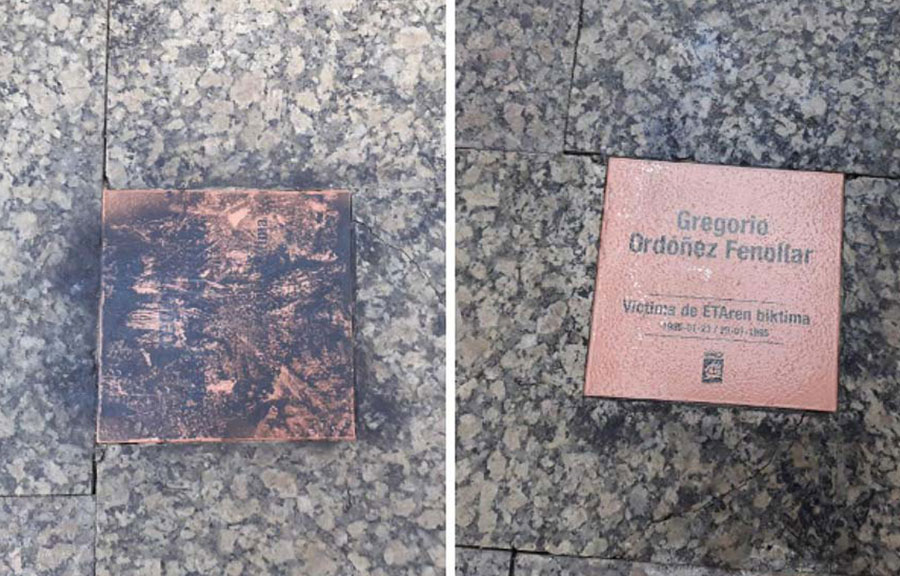
The plaque in memory of Gregorio Ordónez, Deputy Mayor of San Sebastián killed in 1995, was defaced a few days after it was placed in 2020

Damage to plaques in memory of five victims of ETA in San Sebastián
THE MURDER OF THE 85-YEAR-OLD HOLOCAUST SURVIVOR MIREILLE KNOLL. Mireille Knoll, an 85-year-old survivor of the Holocaust, was stabbed to death and her home in district 11 of Paris was set on fire. In 1942, Knoll had managed to escape from the roundup in the Vél d’Hiv, in which more than 13,000 Jews, including 4,000 children, were detained by French police under the Vichy regime and transferred to the Auschwitz extermination camp. Kroll’s mother, the holder of a Brazilian passport, managed to escape to Portugal with Mireille. Knoll later returned to Paris, where she married another Holocaust survivor. He died a few years before she was killed. Once widowed, she lived alone in her apartment. On 23 March 2018 two young men attacked her in her home; they were later accused of a hate crime due to its anti-Semitic nature. It later became known that one of the accused, a Muslim of Maghrebi origin and a neighbour of the victim, had a police record for sexual abuse. Knoll’s killing, preceded one year before by the murder of a Jewish woman, Sarah-Attal-Halimi, brought about a manifesto* against a “new anti-Semitism” signed by 250 French intellectuals, urging French Muslims to show their loyalty to the Republic. In response, about 30 Imams published a letter against the “normalisation of Islamophobia”. In the meantime, Ms Knoll’s son founded the ‘Asociation Mireille Knoll’ to defend tolerance and the values that had inspired his mother’s life.
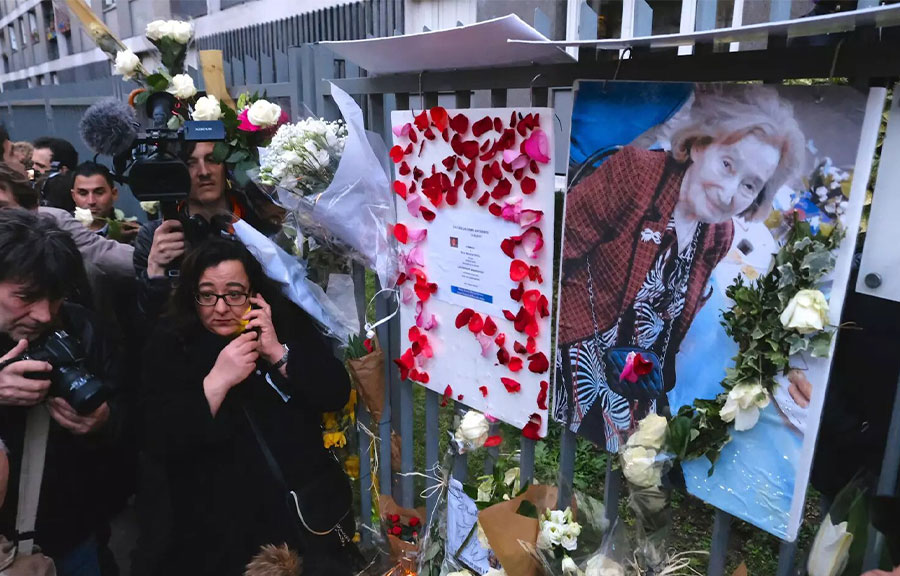
Tribute to Mireille Knoll in a march organised in Paris on 28 March 2018/small>

Tribute to the victims of the Holocaust – plenary session of the European Parliament. January 2020
THREATS, GRAFFITI AND INSULTS AGAINST THE ITALIAN SENATOR LILIANA SEGRE, A HOLOCAUST SURVIVOR (1930). Liliana Segre was born in Milan into a Jewish family. Her mother, Lucía Foligno, died when Liliana was one year old, so she grew up with her father Alberto Segre and her paternal grandparents, Giuseppe Segre and Olga Loevvy. At the age of eight she was a victim of Fascist laws that stopped her from going to school. In December 1943, she tried to flee to Switzerland with her father and two cousins, but they were arrested in the province of Varese. After around 40 days in jail, they took her to platform 21 in Milan’s central station and put her on a train bound for the Auschwitz-Birkenau concentration camp. It was 30 January 1944 and Liliana was 13 years old. No other member of her family survived Auschwitz. In 1990, when she turned 60 and became a grandmother, she started to give talks in schools to raise awareness among the younger generations. On 19 January 2018 she was named Life Senator, a post only for great Italian personalities. Her high public profile led to threats, which the Italian Anti-Semitism Observatory estimated at 200 in a single day. She has been given police protection by the Italian Government.
THREATS, GRAFFITI AND INSULTS AGAINST THE ITALIAN SENATOR LILIANA SEGRE, A HOLOCAUST SURVIVOR (1930). Liliana Segre was born in Milan into a Jewish family. Her mother, Lucía Foligno, died when Liliana was one year old, so she grew up with her father Alberto Segre and her paternal grandparents, Giuseppe Segre and Olga Loevvy. At the age of eight she was a victim of Fascist laws that stopped her from going to school. In December 1943, she tried to flee to Switzerland with her father and two cousins, but they were arrested in the province of Varese. After around 40 days in jail, they took her to platform 21 in Milan’s central station and put her on a train bound for the Auschwitz-Birkenau concentration camp. It was 30 January 1944 and Liliana was 13 years old. No other member of her family survived Auschwitz. In 1990, when she turned 60 and became a grandmother, she started to give talks in schools to raise awareness among the younger generations. On 19 January 2018 she was named Life Senator, a post only for great Italian personalities. Her high public profile led to threats, which the Italian Anti-Semitism Observatory estimated at 200 in a single day. She has been given police protection by the Italian Government.

Tribute to the victims of the Holocaust – plenary session of the European Parliament. January 2020
The fact that the data collection to draft this report ran into the first half of 2020 has shed light on recent phenomenon: acts of hatred related to Covid-19. A total of 70 have been recorded, 65 of which have been direct attacks on people. The most common form of attack has been incitement to hate against people of Asian appearance, although in Poland accusations have been made against the LGTBI collective and Jews, holding them responsible for spreading the virus. In any case, less activity among observatories and civil society in general means that fewer cases were compiled, although they have undoubtedly occurred.
TENS OF PEOPLE BARRACKED AND STONED A CONVOY TAKING 28 ELDERLY PEOPLE WITH CORONAVIRUS from a care home in Alcalá del Valle to be accommodated elsewhere
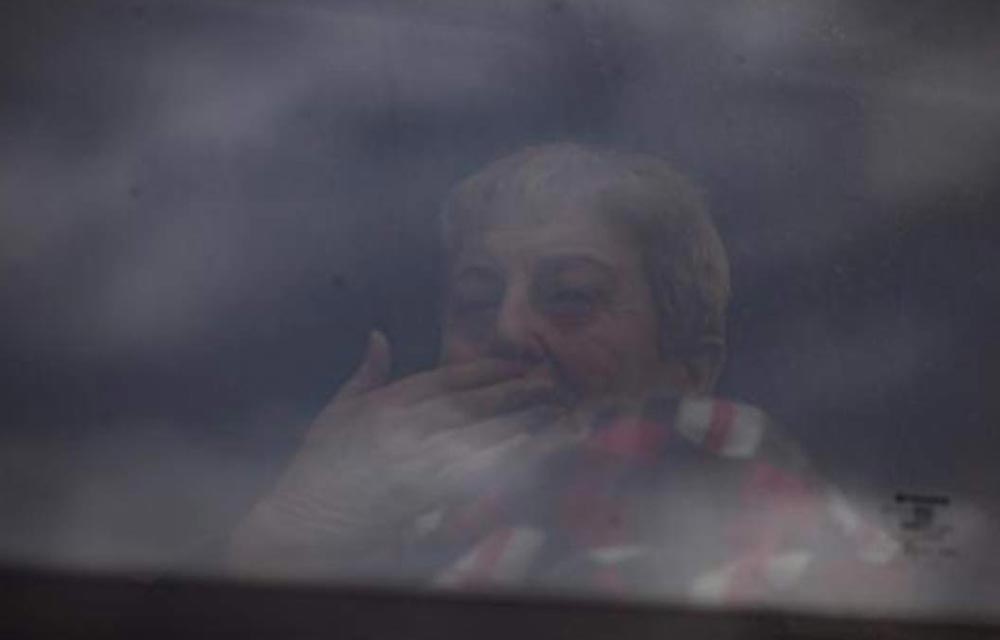
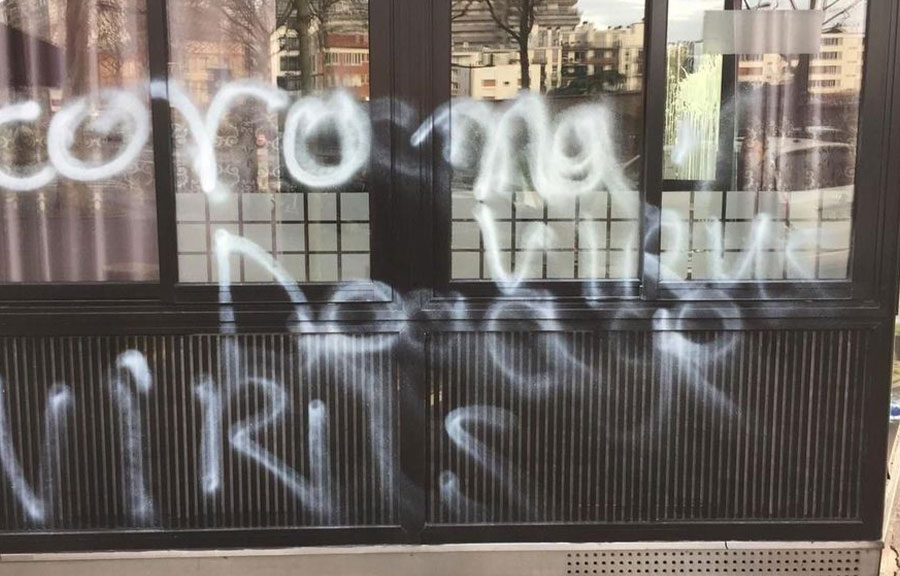
ATTACK ON A JAPANESE RESTAURANT RUN BY A CHINESE WOMAN, WITH COVID-19 GRAFFITI IN BOULOGNE-BILLANCOURT (FRANCIA). The owners of Yuki, a Japanese restaurant in Boulogne-Billancourt (near Paris), reported racist graffiti referring to the spread the Covid-19 virus and the Asian origin of the owners, a family that had run the business for more than twenty years. In the light of this and other racist attacks against the Asian community in France, the hashtag #JeNeSuisPasUnVirus became popular.

Restaurante yuki, Boulogne-Billancourt
![]()
Fuente: FRA, Le Parisien
ATTACK ON A JAPANESE RESTAURANT RUN BY A CHINESE WOMAN, WITH COVID-19 GRAFFITI IN BOULOGNE-BILLANCOURT (FRANCIA). The owners of Yuki, a Japanese restaurant in Boulogne-Billancourt (near Paris), reported racist graffiti referring to the spread the Covid-19 virus and the Asian origin of the owners, a family that had run the business for more than twenty years. In the light of this and other racist attacks against the Asian community in France, the hashtag #JeNeSuisPasUnVirus became popular.

Restaurante yuki, Boulogne-Billancourt

Fuente: FRA, Le Parisien

A GROUP OF PEOPLE BOOED AND THREW STONES AT NATIONAL POLICE OFFICERS guarding the site. Two people were arrested.
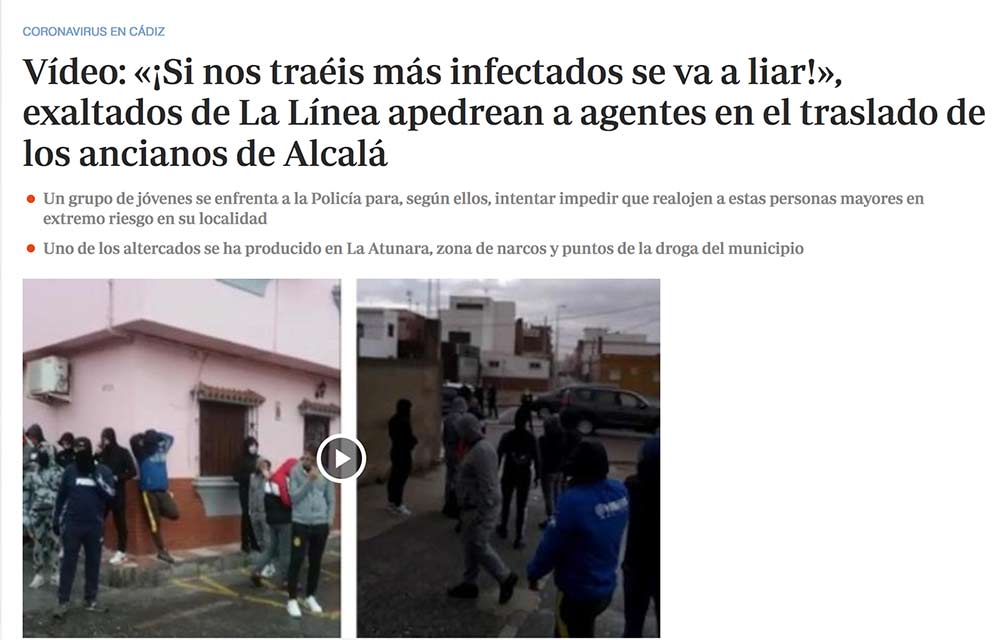
DATA FROM THE NATIONAL OBSERVATORY OF ATTACKS BY THE SPANISH MEDICAL ASSOCIATION (OMC) RECORDED 441 VIOLENT INCIDENTS AGAINST HEALTH WORKERS IN 2020
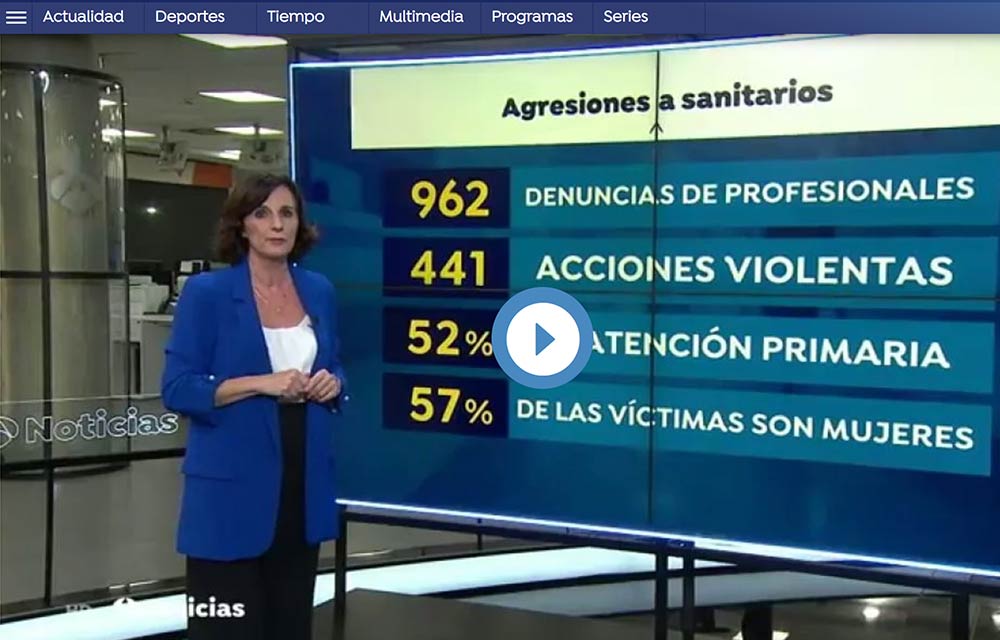
A detailed analysis of the cases shows 225 acts of hatred where hate is released in different forms and against people of different groups, not just one motive or group. In 141 of the cases an initial motive (anti-Romany, homophobia or Islamophobia) is joined by racism and xenophobia as secondary motivations. Moreover, 62 anti-Semitic acts involved the persecution of, or attacks on, Holocaust victims. Double-motive attacks seem particularly common in Spain, which recorded twenty-two acts in 2019 in which attacks on members of the Security Forces and/or their families were simultaneous manifestations of political intolerance, all in the context of Catalonia. The aggressors consider it legitimate to name, persecute and attack the Security Forces, constitutionalist politicians and members of the judiciary system. This means that many of the incidents should be classified as attacks on the Rule of Law in Spain.
In this study 27 types of violent acts have been identified in which acts of hate have taken place. Almost 25% of them were violent attacks, while 15% were acts of vandalism and 10% graffiti. Our sources do not specify the modus operandi in approximately 20% of acts.
Table 13: Total percentages of types of hate crimes by motivation and country, Civil Society Data

| Assaults | |
|---|---|
| Germany | 17% |
| Spain | 25,56% |
| France | 17,58% |
| Hungary | 18,25% |
| Italy | 33,67% |
| Poland | 23,34% |

| Fatal assaults | |
|---|---|
| German | 2,01% |
| Spain | 2,35% |
| France | 0,37% |
| Hungary | 0,00% |
| Italy | 1,91% |
| Poland | 0,91% |

| Attacks on politicians | |
|---|---|
| Germany | — |
| Spain | 0,07% |
| France | — |
| Hungary | — |
| Italy | — |
| Poland | — |

| Covid-19 discrimination* | |
|---|---|
| Germany | — |
| Spain | — |
| France | — |
| Hungary | — |
| Italy | 0,09% |
| Poland | — |
* Datos de los primeros 6 meses de 2021

| Desecration of graves | |
|---|---|
| Germany | 0,40% |
| Spain | 0,37% |
| France | 48,56% |
| Hungary | 0,73% |
| Italy | 0,73% |
| Poland | 2,08% |

| Harassment | |
|---|---|
| Germany | — |
| Spain | 3,37% |
| France | — |
| Hungary | — |
| Italy | — |
| Poland | — |

| Fires | |
|---|---|
| Germany | 5,13% |
| Spain | 1,54% |
| France | 5,28% |
| Hungary | 0,73% |
| Italy | 5,17% |
| Poland | 1,04% |

| Graffiti | |
|---|---|
| Germany | 11,77% |
| Spain | 16,23% |
| France | 6,02% |
| Hungary | 28,47% |
| Italy | 7,62% |
| Poland | 7,81% |

| Incitement to hatred | |
|---|---|
| Germany | 0,50% |
| Spain | 0,89% |
| France | 0,43% |
| Hungary | 2,92% |
| Italy | 1,91% |
| Poland | 8,85% |

| Incitement to hatred in schools | |
|---|---|
| Germany | — |
| Spain | 0,44% |
| France | — |
| Hungary | — |
| Italia | 0,82% |
| Poland | 0,26% |

| Incitement to hatred in sporting events | |
|---|---|
| Germany | — |
| España | — |
| France | — |
| Hungary | — |
| Italy | 8,53% |
| Poland | 7,42% |

| Insults | |
|---|---|
| Germany | 1,01% |
| Spain | 1,69% |
| France | 0,74% |
| Hungary | 1,45% |
| Italy | 9,17% |
| Polan | 6,64% |

| Language imposition | |
|---|---|
| Germany | — |
| Spain | 0,51% |
| France | — |
| Hungary | — |
| Italy | — |
| Poland | — |

| Non-specified | |
|---|---|
| Germany | 38% |
| Spain | 6,02% |
| France | 33,9% |
| Hungary | 27% |
| Italy | 3,18% |
| Poland | 12,5% |

| Online attacks | |
|---|---|
| Germany | — |
| Spain | 1,32% |
| France | 0,12% |
| Hungary | — |
| Italy | 0,45% |
| Poland | 0,65% |

| Exalting Nazism | |
|---|---|
| Germany | 0,30% |
| Spain | 19,10% |
| France | 0,88% |
| Hungary | 2,92% |
| Italy | 1,18% |
| Poland | 1,95% |

| Theafts | |
|---|---|
| Germany | 1,21% |
| Spain | 1,69% |
| France | 4,67% |
| Hungary | 0,73% |
| Italy | 4,54% |
| Poland | 2,08% |

| Civil disorder | |
|---|---|
| Germany | — |
| Spain | 0,53% |
| France | — |
| Hungary | — |
| Italy | 0,27% |
| Poland | 0,13% |

| Exalting terrorism | |
|---|---|
| Germany | — |
| Spain | 9,32% |
| France | — |
| Hungary | — |
| Italy | — |
| Poland | 0,13% |

| Vandalism | |
|---|---|
| Germany | 13,28% |
| Spain | 19,94% |
| France | 18,6% |
| Hungary | 10,22% |
| Italy | 9,8% |
| Poland | 14,84% |

| Threats | |
|---|---|
| Germany | 8,35% |
| Spain | 7,78% |
| France | 4,73% |
| Hungary | 5,84% |
| Italy | 10,16% |
| Poland | 4,70% |

| Sexual assaults | |
|---|---|
| Germany | — |
| Spain | — |
| France | — |
| Hungary | — |
| Italy | 0,27% |
| Poland | 0,13% |

| Kidnappings | |
|---|---|
| Germany | — |
| Spain | — |
| France | — |
| Hungary | — |
| Italy | 0,36% |
| Poland | 0,13% |

| Independence symbols | |
|---|---|
| Germany | — |
| Spain | 0,15% |
| France | — |
| Hungary | — |
| Italy | — |
| Poland | — |

| Insults at sporting events | |
|---|---|
| Germany | 0,10% |
| Spain | — |
| France | — |
| Hungary | 0,73% |
| Italy | — |
| Poland | — |
Total
Porcentajes (%)
* The absence of data on hate crimes in Poland and Hungary is symptomatic of the lack of control over the data.




